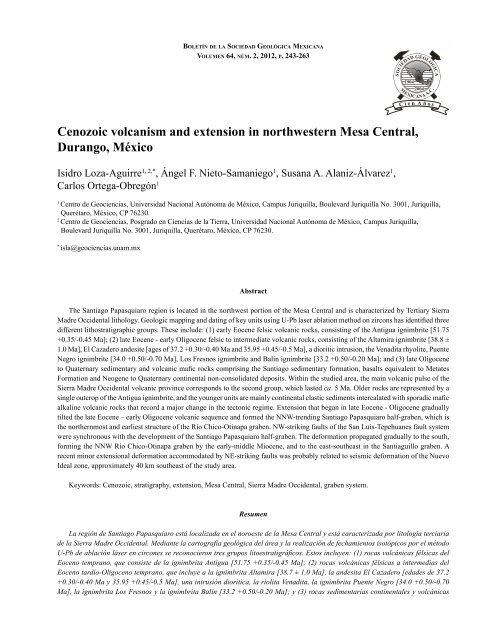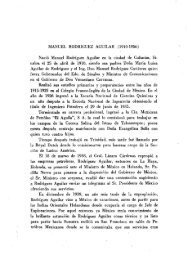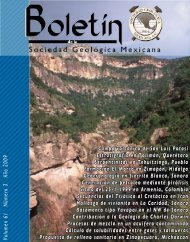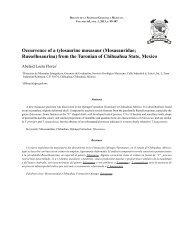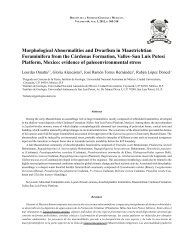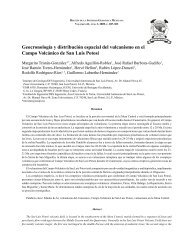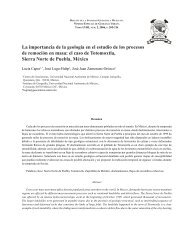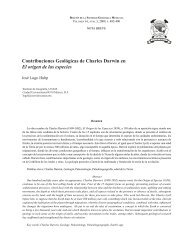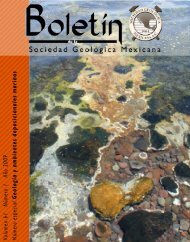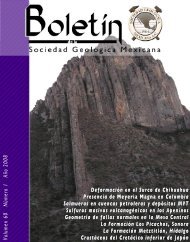Cenozoic volcanism and extension in northwestern Mesa Central ...
Cenozoic volcanism and extension in northwestern Mesa Central ...
Cenozoic volcanism and extension in northwestern Mesa Central ...
You also want an ePaper? Increase the reach of your titles
YUMPU automatically turns print PDFs into web optimized ePapers that Google loves.
Figure 1<strong>Cenozoic</strong> <strong>volcanism</strong> <strong>and</strong> <strong>extension</strong> <strong>in</strong> <strong>northwestern</strong> <strong>Mesa</strong> <strong>Central</strong>, Durango, México 245SMOc106°W 102°WHPBTEPTG105°W 104°W 103°W 102°W 101°WGPC24°N 26°NMSPESRDGP100 kmMCFSPSGRCOGRHGCTDurangoDVFFresnilloZacatecas25°N24°N23°NSLPMéxico750 kmNormalFault<strong>Mesa</strong> <strong>Central</strong>100 kmGuadalajaraSan Luis - Tepehuanes Fault SystemADGOAguascalientesLeónSLDPQ22°N21°NFigure 1. Geographic location of the study area. A) Durango State is located <strong>in</strong> central northwest México. B) Light gray th<strong>in</strong> l<strong>in</strong>es represent the roadsthat connect the pr<strong>in</strong>cipal cities <strong>and</strong> towns <strong>in</strong> the region: Hidalgo del Parral (HP), Gómez Palacio (GP), Rodeo (R), Santiago Papasquiaro (SP), Mazatlán(M), El Salto (ES); Fresnillo (F), Durango (D). Gray shaded area represents the Sierra Madre Occidental volcanic prov<strong>in</strong>ce (SMOc) (Ferrari et al., 2005),<strong>and</strong> the <strong>Mesa</strong> <strong>Central</strong> (MC) is delimited by thick gray l<strong>in</strong>e (Nieto-Samaniego et al., 2005). The box enclos<strong>in</strong>g SP represents the study area. C) Regionalstructural map of the <strong>Mesa</strong> <strong>Central</strong> <strong>and</strong> surround<strong>in</strong>gs (Modified from Nieto-Samaniego et al., 2005). The San Luis – Tepehuanes Fault System has a NWgeneral strike <strong>and</strong> a length of almost 600 km from San Luis de La Paz <strong>in</strong> the southeast (SLDP) to Tepehuanes <strong>in</strong> the northwest (TEP). In the northwest <strong>in</strong>gray text: Tepehuanes Graben (TG), Rodeo Half Graben (RHG), Santiaguillo Graben (SG) <strong>and</strong> Río Chico-Ot<strong>in</strong>apa Graben (RCOG). Durango QuaternaryVolcanic Field (DVF) is northeast of Durango City. San Luis Potosí City (SLP), Querétaro City (Q). The <strong>Mesa</strong> <strong>Central</strong> is delimited by thick gray l<strong>in</strong>e.KEovEovStudyAreaEovEovQscPagrOlvEovTepehuanesEovMivOlvMisPzSMDOMisEovMisSantiago PapasquiaroEovMivQscKOlvNuevo IdealOlvPzDurangoKQscRodeoEovE11PasJOlvMisEovJKS75QscEovQvKPasOlvNazasS91PagrMisQscK JQsc QvMis MivOlvEovPas PagrKJPz40 kmQuaternaryMioceneOligoceneEocenePaleoceneCretaceousJurassicPaleozoicFigure 2. Regional geologic map of the <strong>northwestern</strong> <strong>Mesa</strong> <strong>Central</strong> <strong>in</strong> the region between Durango <strong>and</strong> Santa Maria del Oro (SMDO). Includes SantiagoPapasquiaro <strong>and</strong> Durango 1:250000 scale maps. Geology modified from: Mungía-Rojas et al. (1998), Mungía-Rojas et al. (2000), Ferrari et al. (2005),Nieto-Samaniego et al. (2005), SGM (2007). Segmented gray l<strong>in</strong>es delimitate the <strong>in</strong>fluence zone of the San Luis-Tepehuanes fault system <strong>in</strong> this region.
<strong>Cenozoic</strong> <strong>volcanism</strong> <strong>and</strong> <strong>extension</strong> <strong>in</strong> <strong>northwestern</strong> <strong>Mesa</strong> <strong>Central</strong>, Durango, México 247105°25’W105°30’W105°35’WTo TepehuanesEvrS<strong>and</strong>íasEXPLANATIONA'NEvrEl Almagre S.StratigraphyAge MaEpochPeriodEpni EpniMsfPuente Negro S.Tía L<strong>in</strong>a S.José SalomeAcostaPnqsHoloceneOlfiLa Venadita S0.01CorralesPnqsPleistoceneEpniEpniMsfPr<strong>in</strong>cipal roadQuaternaryMsfMsfEpniNeogene-QuaternarySedimentsEpniMsfMsfOlfiPnqs2.58PascualesEpniOlfiMsfAtotonilcoLos HerreraEpniEpniPnqsMsfOlfiOlfiOlfiEpniPnqsMsfOlfiMsfPnqsEpniMmfMsfMsfOlfiMmfGaramede AbajoOlfiOlfiEvrPnqsOlfiMsfMsfEvrEaliEaiEecaEaliEecaMmfEecaEaliObiEvrObiObiObiObiObiObiObiSecondary roadObiPliocene5.33RiverMetates Formation10.63 ± 0.05 MaMmf1(Ar-Ar )Ephemeral RiverMioceneNeogeneNormal FaultEdiSantiago FormationMsf23.03Photo<strong>in</strong>terpretatednormal faultBal<strong>in</strong> ignimbrite+0.5 33.2 / -0.20 2Ma (U-Pb )OligoceneALos Fresnos ignimbritePuente Negro i gnimbrite+0.50 34.0 / -0.70 2Ma (U-Pb )Venadita rhyoliteDioritic <strong>in</strong>trusionEl Cazadero aObiOlfiEpniEvrEdiEecaFres-b33.9L<strong>in</strong>ementPaleogeneRock samplelocationndesite+0.30 37.2 / -0.40 2Ma (U-Pb )Obi25°05’N25°10’NAltamira i gnimbrite338.7 ± 1.0 Ma (K-Ar )EaliCaz-lPas-wbEoceneB'And-clEl CazaderoEl Cazadero S.Antigua ignimbrite51.75 +0.35 / -0.45 2Ma (U-Pb )Eai55.8To Nuevo IdealGEOLOGICAL MAPSANTIAGO PAPASQUIARO, DGO.TOPOGRAPHIC BASE INEGI (G13C48)Santa Lucía S.BSANTIAGOPAPASQUIARO0 1 2 3 4 5 KmEl Cardo S.1 2Iriondo et al. (2004), Present wordk U-Pb dates: Antigua ignimbrite,sample fres-b; El Cazadero <strong>and</strong>esite, sample <strong>and</strong>-cl; Puente Negro ignimbrite,3sample pas-nc; Bal<strong>in</strong> ignimbrite, sample pas-wb. Barajas-Gea (2008).To Francisco Javier LeyvaTo Los AltaresFigure 4. Geologic map of Santiago Papasquiaro, Durango State, scale 1:50,000 made on the topographic base map G13-C48 (INEGI, 2000). Shownare the isotopic ages obta<strong>in</strong>ed dur<strong>in</strong>g the present work <strong>and</strong> those previously published by others. The Santiago Papasquiaro valley has a NW strike <strong>in</strong> thenorthern portion <strong>and</strong> a NNW strike <strong>in</strong> the center <strong>and</strong> south portions.
<strong>Cenozoic</strong> <strong>volcanism</strong> <strong>and</strong> <strong>extension</strong> <strong>in</strong> <strong>northwestern</strong> <strong>Mesa</strong> <strong>Central</strong>, Durango, México 249Table 2. Petrographic summary of lithostratigraphic units.Unit NameMetates FormationSantiagoformationBalín ignimbriteLos FresnosignimbritePuente Negroignimbritef<strong>in</strong>e gra<strong>in</strong>, holo -hypocrystall<strong>in</strong>emedium gra<strong>in</strong>,hypocrystall<strong>in</strong>ef<strong>in</strong>e- mediumgra<strong>in</strong>,hypocrystall<strong>in</strong>emedium gra<strong>in</strong>,hypocrystall<strong>in</strong>e% shape m<strong>in</strong>eral˂ 10 subH- euH pl, bio, pxoct-40subA- subRVenadita rhyolite oct-20 subHEl Cazadero<strong>and</strong>esiteAltamiraignimbriteTexturemedium gra<strong>in</strong>hypocrystall<strong>in</strong>ePhenocrysts20 subH- anH qz, sa, pl ˃˃ bio20- 30 subH- anH qz, sa, bio, pl10 subH qz, sa, pl, bioDioritic <strong>in</strong>trusion 20- 30 euH- subHanHqz, sa, bio, pl, am,˃˃ magpl, am, qz˃˃ ap,ms˂ 25 subH- euH am, pl, qzqz, sa, bio, hb ˃˃ox, olAntigua ignimbrite hypocrystall<strong>in</strong>e 20 anH- subH qz, sa, bio, hbsubH: Subhedral. euH: Euhedral. anH: Anhedral. subA: Subangular. subR:Subrounded.pl: Plagioclase. bio: Biotite. px: Pyroxene. qz: Quartz. sa: Sanid<strong>in</strong>e. am:Amphibole. mag: Magnetite. ap: Apatite. ms: Muscovite. ox: Oxides. ol:Oliv<strong>in</strong>e.Samaniego et al., 2012) <strong>and</strong> 40.15 +0.35/0.95 Ma (U-Pb onzircons, Nieto-Samaniego et al., 2012).3.2.3. Venadita rhyoliteIn the present study the name of Venadita rhyolitewas given to a group of lava domes that overlies theAltamira ignimbrite <strong>and</strong> the El Cazadero <strong>and</strong>esite (Figure4). Outcrops of this unit can be observed <strong>in</strong> some streamslike La Venadita <strong>and</strong> El Almagre <strong>in</strong> the northeast of thestudy area, Santa Lucia <strong>and</strong> El Cardo <strong>in</strong> the southwest, <strong>and</strong>Puente Negro <strong>and</strong> Tía L<strong>in</strong>a <strong>in</strong> the north (Figure 4). Generalmacroscopic <strong>and</strong> microscopic characteristics are shown <strong>in</strong>Tables 1 <strong>and</strong> 2. Commonly, the rhyolite has basal vitrophyres<strong>and</strong> autobreccias as well as flow foliation. Spherulitic textureis developed <strong>in</strong> some outcrops. The matrix is devitrified<strong>and</strong> presents perlitic fractures <strong>in</strong> th<strong>in</strong> section. The Venaditarhyolite unconformably underlies the Puente Negroignimbrite. Due to lithological features <strong>and</strong> stratigraphicposition this unit has similarities with the rhyolitic domeof 34 ± 0.8 Ma reported <strong>in</strong> Nazas region (Aguirre-Díaz <strong>and</strong>McDowell, 1991). For that reason, we consider the Venaditarhyolite of late Eocene-early Oligocene age.3.2.4. Puente Negro ignimbritePuente Negro ignimbrite is a massive pyroclasticdeposit that crops out <strong>in</strong> the northern <strong>and</strong> northeasternparts of the study area (Figure 4, Tables 1 <strong>and</strong> 2). Thisunit forms large tilted plateaus <strong>in</strong> the central-northern0.078a) data-po<strong>in</strong>t error ellipses are 2σb)95Fres-bFres-bbox heights are 2σ207 207Pb/ Pb0.0720.0660.0600.0540.04811070Age85756555TuffZirc Age= 51.75 +0.35/-0.45 Ma95% confidence, for coherent group of 260.0420.036450.03050 70 90 110 130 150 170238 206U/ Pb35Figure 5. Zircon U-Pb data obta<strong>in</strong>ed by LA-ICP-MS from sample Fres-b of the Antigua ignimbrite. a) Tera-Wasserburg diagram show<strong>in</strong>g concordant datafrom sample Fres-b. Although many of the ellipses touch the concordant curve (which means that they could be considered concordant data), there aresome ellipses that do not. Part of this problem is related to the lack of common lead values (as discussed <strong>in</strong> the <strong>in</strong>troduction), as well as problems relatedto the fact that ablation (23 microns spot) took place probably <strong>in</strong> several layers (outer <strong>and</strong> <strong>in</strong>ner layers) of the zircon that could be slightly different <strong>in</strong> age(therefore, different isotopic composition is mixed dur<strong>in</strong>g analysis). b) Mean weight age diagram for this sample.
250Loza-Aguirre et al.Table 3. Results of the U-Pb isotopic dat<strong>in</strong>g.Unit Name Sample Location Rock type 206 Pb/ 238 U mean age (Ma)Confidence%# of SpotsBal<strong>in</strong> Ignimbrite Pas-wb 105.59° E, 25.08° N Ignimbrite 33.2 +0.50/-0.20 95 27Puente Negro Ignimbrite Pas-nc 105.54° E, 25.19° N Ignimbrite 34.0 +0.50/-0.70 94.3 14El Cazadero Andesite Caz-l 105.56° E, 25.09° N Andesite 35.95 +0.45/-0.5 96.1 12El Cazadero Andesite And-cl 105.54° E, 25.08° N Andesite 37.2 +0.30/-0.40 95 33Antigua Ignimbrite Fres-b 105.57° E, 25.11° N Ignimbrite 51.75 +0.34/-0.45 95 26-- Gm-26 104.79° E, 24.93° N Rhyolite 56.4 +0.50/-0.70 97.8 13part of the area (Figures 3 <strong>and</strong> 4). The Puente Negroignimbrite overlies unconformably the Altamira ignimbrite<strong>and</strong> Venadita rhyolite, <strong>and</strong> underlies unconformably theSantiago formation <strong>and</strong> the Neogene-Quaternary cont<strong>in</strong>entalsediments. A U-Pb age of 34.0 +0.50/-0.70 Ma (Figure 7,Tables 3 <strong>and</strong> 7) was obta<strong>in</strong>ed from a representative sample(Pas-nc). This unit is considered part of the late EoceneearlyOligocene volcanic pulse.3.2.5. Los Fresnos ignimbriteLos Fresnos ignimbrite is a set of pyroclastic depositsthat crop out west <strong>and</strong> northwest of Santiago Papasquiaro,<strong>and</strong> can be observed along the Santiago Papasquiaro-LosAltares highway (Figure 4, Tables 1 <strong>and</strong> 2). They havebeen grouped previously with other volcanic deposits <strong>and</strong>named as “rhyolitic tuff-ignimbrite” by Luévano-P<strong>in</strong>edoet al. (2003). In the bottom of the Los Fresnos ignimbritethere are a series of pyroclastic-flow <strong>and</strong> fall deposits,with a total thickness of 2 m. Individual layers are red <strong>and</strong>yellow <strong>and</strong> have thicknesses of less than 5 cm. Los Fresnosignimbrite overlies unconformably the Antigua ignimbrite,the El Cazadero <strong>and</strong>esite <strong>and</strong> the Venadita rhyolite, <strong>and</strong>underlies conformably the Balín ignimbrite. Los Fresnosignimbrite has not been dated. However, its stratigraphicposition <strong>in</strong>dicates an early Oligocene age, <strong>in</strong>clud<strong>in</strong>g thisunit as part of the late Eocene-early Oligocene ignimbriticpulse (Figure 4).3.2.6. Balín ignimbriteThe name Balín ignimbrite was given to a unit composedof pyroclastic deposits that crop out <strong>in</strong> the western sector ofthe study area, along the Santiago Papasquiaro-Los Altareshighway (Figure 4, Tables 1 <strong>and</strong> 2). In previous studies theserocks were grouped with other deposits <strong>and</strong> were namedgenerically as “rhyolitic tuff-ignimbrite” (Luévano-P<strong>in</strong>edoet al., 2003). In some outcrops, these deposits show pseudostratification<strong>and</strong> poorly developed columnar jo<strong>in</strong>t<strong>in</strong>g. Inthe uppermost portion of the deposit are “pumice holes” upto 10 cm long, which are the voids left by eroded pumicefragments. Near the base of this unit, lithic fragmentsare bigger. The Balín ignimbrite overlies conformablyLos Fresnos ignimbrite <strong>and</strong> discordantly the El CazaderoAndesite. The U-Pb age obta<strong>in</strong>ed from the sample Pas-wbis 33.2 +0.50/-0.20 Ma (Figure 8, Tables 3 <strong>and</strong> 8). Thisdat<strong>in</strong>g places the Balín ignimbrite <strong>in</strong> the early Oligocene.Consider<strong>in</strong>g this age, the Balín ignimbrite is grouped with<strong>in</strong>the late Eocene-early Oligocene ignimbritic pulse.3.2.7. Santiago formationThe Santiago formation is the name proposed forepiclastic light brown-yellowish deposits of medium tocoarse s<strong>and</strong>, gravel <strong>and</strong> conglomerate that crop out <strong>in</strong>the eastern, northern <strong>and</strong> western borders of the SantiagoPapasquiaro valley (Figure 4, Tables 1 <strong>and</strong> 2). Thesedeposits were named <strong>in</strong> previous works as “rhyolitic brecciarhyolitictuff” (Luévano-P<strong>in</strong>edo et al., 2003). The mostaccessible outcrops are along the Santiago Papasquiaro-Nuevo Ideal highway as well as along the SantiagoPapasquiaro-Garame de Abajo road (Figure 4). The Santiagoformation <strong>in</strong>cludes <strong>in</strong>tercalations of cont<strong>in</strong>ental depositsof s<strong>and</strong> <strong>and</strong> conglomerates that are moderately lithified.In the southernmost outcrops these strata are composedof fragments that range <strong>in</strong> size from medium to coarses<strong>and</strong>. Interbedded with the f<strong>in</strong>e gra<strong>in</strong>ed deposits are somelenticular deposits where fragment size <strong>in</strong>creases. In thenorthernmost deposits of this unit the fragments are almost60 cm. The source of these deposits probably was northof the study area because the clasts size <strong>in</strong>creases towardthe north. The Santiago formation overlies unconformablythe Puente Negro ignimbrite <strong>and</strong> underlies unconformablybasalt flows equivalent to the Metates Formation. This unithas similar lithological features <strong>and</strong> stratigraphic positionas the Santa Inés Formation previously reported <strong>in</strong> Nazasby Aguirre-Díaz <strong>and</strong> McDowell (1991); these authors alsodescribed <strong>in</strong> the Nazas area 24 Ma mafic lavas overly<strong>in</strong>gthe Santa Inés Formation; mafic lavas of similar age hadnot been found <strong>in</strong> the Santiago Papasquiaro region. Tak<strong>in</strong>g<strong>in</strong>to account its stratigraphic position, we propose a lateOligocene age for the Santiago Formation (Figure 4).3.3. Miocene3.3.1. Basalt equivalent to the Metates FormationThe Metates Formation was def<strong>in</strong>ed by Córdoba (1963)
252Loza-Aguirre et al.0.0640.0600.056a) b)data-po<strong>in</strong>t error ellipses are 2σ41And-clAnd-cl39box heights are 2σ207 206Pb/ Pb0.052Age370.0480.044400.040150 160 170 180 190363533TuffZirc Age = 37.20 +0.30/-0.40 Ma95% confidence, from coherent group of 33238 206U/ Pb0.0800.070c) data-po<strong>in</strong>t error ellipses are 2σd)41Caz-lCaz-l4039box heights are 2σ207 206Pb/ Pb0.060Age38370.0504240383634360.040150 160 170 180 190238 206U/ Pb3534TuffZirc Age = 35.95 +0.45/-0.05 Ma96.1% confidence, from coherent group of 12Figure 6. Zircon U-Pb data obta<strong>in</strong>ed by LA-ICP-MS for samples And-cl <strong>and</strong> Caz-l of El Cazadero <strong>and</strong>esite. a) Tera-Wasserburg diagram show<strong>in</strong>gconcordant data from sample And-cl. b) Mean weight age diagram for this sample. c) Tera-Wasserburg diagram show<strong>in</strong>g concordant data from sampleCaz-l. d) Mean weight age diagram for this sample.west of Durango City, around 130 km to the south-southeastof Santiago Papasquiaro. Equivalent basalts mapped <strong>in</strong>the study area consist of basaltic flows <strong>and</strong> dikes, whichoverlie <strong>and</strong>/or <strong>in</strong>trude the late Eocene-early Oligoceneignimbritic sequence. Small basalt flows crop out east ofSantiago Papasquiaro (Figure 4). Also, some dikes <strong>and</strong>small flows crop out along the Santiago Papasquiaro-NuevoIdeal highway <strong>and</strong> the Santiago Papasquiaro-FranciscoJavier Leyva road. These lava flows usually present basal<strong>and</strong> upper breccias, <strong>and</strong> some glomerophenocrysts of ca.15 mm (Tables 1 <strong>and</strong> 2). The basalts equivalent to theMetates Formation overlie unconformably the Santiagoformation <strong>and</strong> are <strong>in</strong>tercalated with Neogene-Quaternaryunconsolidated deposits (Figure 4). Iriondo et al. (2004)obta<strong>in</strong>ed Ar-Ar isochron <strong>and</strong> plateau-like ages of 10.63±0.05Ma <strong>and</strong> 10.95±0.02 Ma from one sample of these lavas,locat<strong>in</strong>g this unit at the base of the late Miocene.3.3.2. Neogene-Quaternary sedimentsThe Santiago Papasquiaro half-graben topographicdepression is filled by s<strong>and</strong>, conglomerate <strong>and</strong> lacustr<strong>in</strong>edeposits (Figure 4). The lacustr<strong>in</strong>e deposits are carbonaterich, light colored <strong>and</strong> composed ma<strong>in</strong>ly of f<strong>in</strong>e materialwith isolated lithics, crystals <strong>and</strong> pumice, which are lessthan 5 mm size. They are <strong>in</strong>tercalated with f<strong>in</strong>e to coarsegra<strong>in</strong> s<strong>and</strong> deposits that show cross bedd<strong>in</strong>g. Layer<strong>in</strong>ghas variable thickness from 5 to 20 cm. In the Neogene-Quaternary sediments there also are clast-supportedconglomerates composed of subangular to subroundedvolcanic <strong>and</strong> metamorphic rocks of 2 mm to 15 cm size.These conglomerates are <strong>in</strong>tercalated with other depositscomposed of isolated volcanic clasts of ~20 cm <strong>and</strong>lacustr<strong>in</strong>e fragments, all supported by a clayey matrix. Otherdeposits are composed of medium gra<strong>in</strong> red s<strong>and</strong>s withlacustr<strong>in</strong>e deposit fragments. These s<strong>and</strong>s show <strong>in</strong>cipientstratification, <strong>in</strong> some places clay matrix is present. The
<strong>Cenozoic</strong> <strong>volcanism</strong> <strong>and</strong> <strong>extension</strong> <strong>in</strong> <strong>northwestern</strong> <strong>Mesa</strong> <strong>Central</strong>, Durango, México 253Table 5. LA-ICP-MS U-Pb zircon data from sample And-cl from El Cazadero <strong>and</strong>esite.CORRECTED RATIOS CORRECTED AGES (Ma)Spot number U (ppm) Th (ppm) Th/U 207 Pb/ 206 Pb ±1σ207 Pb/235 U ±1σ206 Pb/238 U ±1σ208 Pb/232 Th ±1σ Rho206 Pb/238 U ±1σ207 Pb/235 U ±1σ207 Pb/206 Pb ±1σ208 Pb/232 Th ±1σ Best age (Ma) ±1σ27 1212 1181 0.89 0.04782 0.00143 0.03583 0.00117 0.00543 0.00007 0.00166 0.00003 0.4 34.9 0.4 36 1 90 65 33.5 0.6 35 050 1798 994 0.5 0.04711 0.00104 0.03539 0.00089 0.00546 0.00007 0.00177 0.00004 0.48 35.1 0.4 35.3 0.9 55 46 35.7 0.8 35 017 938 484 0.47 0.05233 0.00183 0.04029 0.00148 0.00556 0.00006 0.00187 0.00007 0.31 35.7 0.4 40 1 300 72 38 1 36 041 537 293 0.5 0.0522 0.00183 0.04034 0.00152 0.00563 0.00008 0.00183 0.00005 0.37 36.2 0.5 40 1 294 74 37 1 36 147 1019 652 0.58 0.04734 0.00147 0.03674 0.00123 0.00565 0.00007 0.00174 0.00003 0.37 36.3 0.4 37 1 66 62 35.1 0.6 36 033 727 517 0.65 0.04981 0.00144 0.03874 0.00125 0.00567 0.00008 0.00175 0.00004 0.44 36.4 0.5 39 1 186 64 35.3 0.8 36 135 405 318 0.71 0.05085 0.00229 0.03938 0.00186 0.00566 0.00008 0.00177 0.00004 0.3 36.4 0.5 39 2 234 95 35.7 0.8 36 112 495 271 0.5 0.05005 0.002 0.03898 0.00165 0.00567 0.00008 0.00186 0.00005 0.33 36.4 0.5 39 2 197 83 38 1 36 148 614 430 0.64 0.0484 0.00232 0.0379 0.00209 0.00568 0.00007 0.0018 0.00004 0.37 36.5 0.5 38 2 119 98 36.3 0.7 37 151 541 324 0.55 0.05202 0.00249 0.0408 0.00222 0.00569 0.00007 0.00179 0.00002 0.31 36.6 0.5 41 2 286 100 36.1 0.4 37 120 1001 542 0.49 0.05026 0.00225 0.03961 0.00218 0.00572 0.00009 0.0018 0.00002 0.42 36.7 0.6 39 2 207 97 36.4 0.5 37 115 548 477 0.79 0.04924 0.00222 0.0388 0.00207 0.00571 0.00008 0.00181 0.00002 0.39 36.7 0.5 39 2 159 92 36.5 0.5 37 138 553 339 0.56 0.0495 0.00188 0.03913 0.00158 0.00573 0.00008 0.00184 0.00004 0.34 36.8 0.5 39 2 172 81 37.2 0.8 37 152 488 331 0.62 0.05028 0.00247 0.0398 0.00236 0.00574 0.0001 0.00181 0.00003 0.4 36.9 0.6 40 2 208 103 36.6 0.6 37 121 397 200 0.46 0.05043 0.00207 0.03991 0.00172 0.00575 0.00007 0.00194 0.00005 0.31 37 0.4 40 2 215 89 39 1 37 023 489 291 0.54 0.0529 0.00269 0.04197 0.00253 0.00575 0.00009 0.0018 0.00002 0.33 37 0.6 42 2 325 110 36.4 0.5 37 128 415 208 0.46 0.05 0.00228 0.03968 0.00217 0.00576 0.00009 0.00182 0.00003 0.35 37 0.6 40 2 195 99 36.7 0.5 37 134 586 376 0.58 0.0499 0.00185 0.03953 0.00154 0.00577 0.00007 0.00189 0.00005 0.31 37.1 0.4 39 2 190 80 38 1 37 030 678 369 0.5 0.04773 0.00181 0.03788 0.00151 0.00578 0.00007 0.00176 0.00004 0.31 37.2 0.4 38 1 86 79 35.5 0.8 37 032 456 244 0.49 0.04938 0.00193 0.03913 0.00161 0.00579 0.00008 0.00186 0.00005 0.31 37.2 0.5 39 2 166 85 38 1 37 136 508 336 0.6 0.05037 0.00256 0.04018 0.00231 0.00579 0.00007 0.00182 0.00003 0.31 37.2 0.5 40 2 212 107 36.8 0.5 37 153 561 370 0.6 0.0501 0.00195 0.0398 0.00164 0.00579 0.00008 0.00181 0.00004 0.33 37.2 0.5 40 2 200 82 36.6 0.8 37 116 668 490 0.67 0.04906 0.00137 0.03914 0.00121 0.00578 0.00008 0.00179 0.00004 0.43 37.2 0.5 39 1 151 59 36.1 0.8 37 19 741 719 0.88 0.05091 0.00148 0.04056 0.00131 0.00581 0.00008 0.00179 0.00004 0.44 37.3 0.5 40 1 237 64 36.1 0.8 37 126 1721 1073 0.57 0.04853 0.00107 0.03895 0.00096 0.00584 0.00006 0.00198 0.00004 0.45 37.5 0.4 38.8 0.9 125 49 40 0.8 38 039 861 394 0.42 0.0482 0.0014 0.03873 0.00123 0.00584 0.00008 0.00187 0.00005 0.41 37.5 0.5 39 1 109 62 38 1 38 110 377 325 0.78 0.0493 0.00237 0.03943 0.00196 0.00583 0.00008 0.00176 0.00004 0.26 37.5 0.5 39 2 162 100 35.5 0.8 38 144 431 217 0.46 0.04921 0.00216 0.03961 0.00203 0.00584 0.00008 0.00185 0.00003 0.34 37.5 0.5 39 2 158 92 37.3 0.6 38 111 427 253 0.54 0.05368 0.00331 0.04317 0.00301 0.00583 0.0001 0.00183 0.00003 0.31 37.5 0.6 43 3 358 126 36.9 0.6 38 18 638 548 0.78 0.04942 0.00148 0.0399 0.00132 0.00585 0.00008 0.0018 0.00004 0.43 37.6 0.5 40 1 168 66 36.3 0.8 38 118 501 330 0.6 0.05289 0.00153 0.04294 0.00136 0.00587 0.00008 0.00191 0.00005 0.41 37.7 0.5 43 1 324 62 39 1 38 124 486 276 0.52 0.05413 0.00206 0.04357 0.00175 0.00586 0.00008 0.00179 0.00004 0.32 37.7 0.5 43 2 376 81 36.1 0.8 38 142 879 614 0.63 0.05033 0.00258 0.04076 0.00245 0.00587 0.00009 0.00185 0.00003 0.48 37.8 0.5 41 2 210 108 37.4 0.5 38 114 298 138 0.42 0.05327 0.00229 0.04449 0.00203 0.00607 0.00009 0.00201 0.00007 0.34 39 0.6 44 2 340 87 41 1 39 1
254Loza-Aguirre et al.Table 6. LA-ICP-MS zircon data from sample Caz-l of El Cazadero <strong>and</strong>esite.CORRECTED RATIOS CORRECTED AGES (Ma)Spot number U (ppm) Th (ppm) Th/U 207 Pb/ 206 Pb ±1σ207 Pb/235 U ±1σ206 Pb/238 U ±1σ208 Pb/232 Th ±1σ Rho206 Pb/238 U ±1σ207 Pb/235 U ±1σ207 Pb/206 Pb ±1σ208 Pb/232 Th ±1σ Best age (Ma) ±1σ17 727 383 0.58 0.0497 0.00166 0.03796 0.00141 0.00554 0.00004 0.00175 0.00001 0.28 35.6 0.3 38 1 181 74 35.3 0.3 36 033 563 314 0.61 0.0545 0.00153 0.04168 0.0012 0.00556 0.00004 0.00179 0.00003 0.22 35.7 0.3 41 1 392 64 36.1 0.6 36 018 638 667 1.15 0.04907 0.00157 0.03788 0.00124 0.00558 0.00004 0.00168 0.00003 0.21 35.9 0.3 38 1 151 75 33.9 0.6 36 039 776 617 0.87 0.04935 0.00104 0.03797 0.00083 0.00558 0.00003 0.00172 0.00003 0.27 35.9 0.2 37.8 0.8 164 48 34.7 0.6 36 010 563 382 0.74 0.05761 0.00138 0.04455 0.00114 0.00559 0.00005 0.00169 0.00003 0.35 35.9 0.3 44 1 515 52 34.1 0.6 36 042 896 683 0.84 0.04683 0.00158 0.03602 0.00137 0.00558 0.00004 0.00178 0.00002 0.32 35.9 0.3 36 1 40 69 35.9 0.5 36 041 585 329 0.62 0.04884 0.00174 0.03777 0.00149 0.00561 0.00004 0.00178 0.00002 0.24 36 0.3 38 1 140 79 35.9 0.3 36 012 609 427 0.77 0.05108 0.00153 0.03925 0.0013 0.00562 0.00008 0.00169 0.00003 0.43 36.1 0.5 39 1 244 68 34.1 0.6 36 136 580 406 0.77 0.05132 0.00139 0.03988 0.00111 0.00563 0.00004 0.00171 0.00003 0.23 36.2 0.3 40 1 255 61 34.5 0.6 36 011 529 323 0.67 0.04675 0.00145 0.03678 0.00118 0.00567 0.00004 0.00163 0.00004 0.26 36.4 0.3 37 1 36 64 32.9 0.8 36 09 572 324 0.62 0.05 0.00165 0.03977 0.00134 0.00573 0.00004 0.00185 0.00004 0.2 36.8 0.3 40 1 195 77 37.4 0.8 37 014 834 574 0.76 0.05153 0.00134 0.0406 0.00109 0.00573 0.00004 0.00181 0.00003 0.25 36.8 0.3 40 1 265 59 36.6 0.6 37 015 596 421 0.78 0.0509 0.00237 0.04046 0.00212 0.00576 0.00006 0.00182 0.00002 0.27 37.1 0.4 40 2 236 105 36.7 0.3 37 08 1041 634 0.67 0.05134 0.00113 0.04086 0.00094 0.00578 0.00004 0.00171 0.00003 0.29 37.2 0.3 40.7 0.9 256 51 34.5 0.6 37 024 462 233 0.55 0.05518 0.00149 0.0445 0.00125 0.00583 0.00005 0.00187 0.00004 0.28 37.5 0.3 44 1 420 61 37.8 0.8 38 026 333 196 0.65 0.05778 0.00196 0.04619 0.00165 0.00584 0.00006 0.00144 0.00005 0.31 37.5 0.4 46 2 521 75 29 1 38 035 270 188 0.76 0.05778 0.00231 0.04631 0.0019 0.00583 0.00005 0.0023 0.00044 0.23 37.5 0.3 46 2 521 86 46 9 38 040 511 312 0.67 0.05123 0.00274 0.04121 0.00296 0.00583 0.00014 0.00184 0.00003 0.61 37.5 0.9 41 3 251 120 37.1 0.7 38 116 1767 1082 0.67 0.04695 0.00085 0.03778 0.00071 0.00583 0.00003 0.0017 0.00002 0.27 37.5 0.2 37.7 0.7 47 39 34.3 0.4 38 034 970 554 0.63 0.05059 0.00111 0.04067 0.00095 0.00585 0.00005 0.00156 0.00003 0.34 37.6 0.3 40.5 0.9 222 51 31.5 0.6 38 038 1239 460 0.41 0.04889 0.00098 0.03956 0.00084 0.00587 0.00004 0.00177 0.00003 0.33 37.7 0.3 39.4 0.8 143 46 35.7 0.6 38 020 424 241 0.62 0.05867 0.00217 0.04763 0.00182 0.00593 0.00006 0.00185 0.00004 0.25 38.1 0.4 47 2 555 82 37.4 0.8 38 027 594 331 0.61 0.05319 0.0016 0.04348 0.00135 0.00592 0.00004 0.00188 0.00003 0.25 38.1 0.3 43 1 337 69 38 0.6 38 022 1729 1176 0.75 0.05024 0.0009 0.0412 0.00078 0.00594 0.00004 0.00179 0.00003 0.32 38.2 0.3 41 0.8 206 42 36.1 0.6 38 023 844 751 0.98 0.04971 0.00129 0.04172 0.00121 0.0061 0.00008 0.00187 0.00003 0.45 39.2 0.5 42 1 181 61 37.8 0.6 39 1
<strong>Cenozoic</strong> <strong>volcanism</strong> <strong>and</strong> <strong>extension</strong> <strong>in</strong> <strong>northwestern</strong> <strong>Mesa</strong> <strong>Central</strong>, Durango, México 255207 206Pb/ Pb0.180.160.140.120.100.080.060.04a) data-po<strong>in</strong>t error ellipses are 2σb)Pas-nc4341Pas-nc3937353331423429Agebox heights are 2σTuffZirc Age = 34.00 +0.50/-0.70 Ma94.3% confidence,from coherent group of 140.02130 150 170 190 210 230238 206U/ PbFigure 7. Zircon U-Pb data obta<strong>in</strong>ed by LA-ICP-MS for sample Pas-nc of the Puente Negro ignimbrite. a) Tera-Wasserburg diagram show<strong>in</strong>g concordantdata from sample Pas-nc. b) Mean weight age diagram for this sample.27estimated thickness for the Neogene-Quaternary sedimentsis around 300 m (INEGI, 1990). These deposits conta<strong>in</strong><strong>in</strong>tercalated basaltic lavas (equivalent to the MetatesFormation) <strong>and</strong> overlie unconformably the Santiagoformation <strong>and</strong> the Puente Negro ignimbrite, show<strong>in</strong>g astratigraphic range from Neogene to Quaternary (Figure 4).3.4. Dioritic <strong>in</strong>trusionA dioritic <strong>in</strong>trusive neck crops out west-southwest ofLos Herrera (Figure 4, Tables 1 <strong>and</strong> 2). This <strong>in</strong>trusion wasreported previously by Mungía-Rojas et al. (2000) <strong>and</strong>Luévano-P<strong>in</strong>edo et al. (2003). This body <strong>in</strong>trudes rocks ofthe El Cazadero <strong>and</strong>esite of late Eocene age.4. Structure of the Santiago Papasquiaro valleyThe Santiago Papasquiaro valley is formed by NNW<strong>and</strong> NW strik<strong>in</strong>g blocks tilted to the southwest (Figures 3, 4<strong>and</strong> 9). The tilted blocks of the Santiago Papasquiaro valleywere formed <strong>in</strong> the <strong>in</strong>tersection of two major fault systems:the San Luis-Tepehuanes NW-strik<strong>in</strong>g fault system (SLTFS)<strong>and</strong> the Río Chico-Ot<strong>in</strong>apa NNW graben (RCOG) (Figures1 <strong>and</strong> 3) (Nieto-Samaniego et al., 2005). The Tepehuanes<strong>and</strong> Santiaguillo grabens are part of the SLTFS (Figure 3)(Nieto-Samaniego et al., 2012). Between the Santiaguillo<strong>and</strong> Tepehuanes grabens there is a zone with NW faults thatproduce elongated blocks tilted to the southwest (Figures3, 4 <strong>and</strong> 9). The second system is formed of several NNWgrabens <strong>and</strong> half grabens that form a tectonic depressionthat is ~150 km long <strong>and</strong> averages 10 km wide (Figure 3).The northernmost structure of the RCOG is the SantiagoPapasquiaro half-graben, which is oriented N15°W <strong>and</strong> is~40 km long <strong>and</strong> ~10 km wide. With<strong>in</strong> the study area themaster faults of both the SLTFS <strong>and</strong> RCOG are located <strong>in</strong> thewestern border of the Santiago Papasquiaro valley (Figures3, 4 <strong>and</strong> 9). Those faults separate the Neogene-Quaternarysediments from the late Eocene-early Oligocene volcanicunits. The estimated throw of the Santiago Papasquiaro halfgraben(RCOG) is around 200 m, but consider<strong>in</strong>g throwsof the adjacent major faults, the total throw is around 600m (Figures 4 <strong>and</strong> 9). The throw of the SLTFS master faultis 500 m, add<strong>in</strong>g the throws of the adjacent major faults,the total estimated throw reaches 800 m (Figures 4 <strong>and</strong> 9).The average strike of the measured planes is NNW,<strong>and</strong> there is no significant difference between northern <strong>and</strong>southern portions of the measured fault planes (Figure 10).As seen <strong>in</strong> Figure 3, the average strike of SLTFS <strong>and</strong> RCOGis very similar at Santiago Papasquiaro latitude. Althoughthe slickenl<strong>in</strong>es show large dispersion, the movement isma<strong>in</strong>ly normal to left oblique (Figure 10). Calculated stra<strong>in</strong>tensors, us<strong>in</strong>g the dynamic analysis of Spang (1972), showm<strong>in</strong>imum pr<strong>in</strong>cipal stress oriented 230/01 for the northernpart of the study area <strong>and</strong> 244/05 for the southern part(Figure 10). We can see that <strong>in</strong>version results are similarfor both analyses, consider<strong>in</strong>g separately northern <strong>and</strong>southern data; this means that very similar stra<strong>in</strong> tensorswere obta<strong>in</strong>ed for both SLTFS <strong>and</strong> the Santiago Papasquiarohalf-graben (Figure 10).5. Geologic EvolutionMost of the volcanic rocks <strong>in</strong> this portion of the <strong>Mesa</strong><strong>Central</strong> were emplaced dur<strong>in</strong>g the Eocene <strong>and</strong> Oligocenetime. Two pulses can be identified: one occurred dur<strong>in</strong>gthe Paleocene-middle Eocene <strong>and</strong> the other dur<strong>in</strong>g the lateEocene-early Oligocene (Figure 11). From the Mioceneto Recent, volcanic activity was scattered <strong>and</strong> sporadic.
256Loza-Aguirre et al.Table 7. LA-ICP-MS zircon data from sample Pas-nc of Puente Negro ignimbrite.CORRECTED RATIOS CORRECTED AGES (Ma)Spot number U (ppm) Th (ppm) Th/U 207 Pb/ 206 Pb ±1σ207 Pb/235 U ±1σ206 Pb/238 U ±1σ208 Pb/232 Th ±1σ Rho206 Pb/238 U ±1σ207 Pb/235 U ±1σ207 Pb/206 Pb ±1σ208 Pb/232 Th ±1σ Best age (Ma) ±1σ18 251 313 1.17 0.04609 0.00811 0.02985 0.00583 0.0047 0.00008 0.00166 0.0002 0.24 30.2 0.5 30 6 2 292 33 4 30 134 292 351 1.13 0.05099 0.00362 0.03325 0.00264 0.00473 0.00006 0.00149 0.00002 0.21 30.4 0.4 33 3 240 157 30.1 0.4 30 026 224 188 0.79 0.08988 0.02517 0.06013 0.01685 0.00486 0.00005 0.00167 0.00004 0.04 31.3 0.3 59 16 1423 577 33.7 0.8 31 022 327 382 1.1 0.06364 0.01601 0.04322 0.01188 0.00493 0.00015 0.00151 0.00008 0.44 31.7 1 43 12 730 500 31 2 32 123 376 480 1.2 0.06775 0.0052 0.04648 0.00458 0.00498 0.00013 0.00152 0.00003 0.54 32 0.9 46 4 861 157 30.6 0.6 32 124 240 254 0.99 0.06356 0.00699 0.04358 0.00523 0.00497 0.00008 0.00153 0.00002 0.22 32 0.5 43 5 727 234 30.8 0.4 32 127 73 104 1.34 0.09994 0.0116 0.06914 0.00921 0.00502 0.00014 0.00147 0.00004 0.32 32.3 0.9 68 9 1623 216 29.6 0.7 32 110 127 113 0.83 0.07489 0.00821 0.05297 0.00633 0.00513 0.0001 0.00154 0.00003 0.32 33 0.7 52 6 1066 209 31.2 0.6 33 116 176 189 1.01 0.07647 0.00958 0.05432 0.00761 0.00515 0.00012 0.00155 0.00003 0.43 33.1 0.8 54 7 1107 238 31.3 0.6 33 136 143 87 0.57 0.05625 0.00627 0.04018 0.00473 0.00518 0.00009 0.00161 0.00004 0.23 33.3 0.6 40 5 462 233 32.6 0.7 33 114 184 138 0.7 0.07201 0.00382 0.05148 0.00279 0.00518 0.00006 0.0016 0.00005 0.2 33.3 0.4 51 3 986 101 32 1 33 015 167 125 0.7 0.06725 0.00541 0.04814 0.00419 0.00519 0.00007 0.00158 0.00002 0.27 33.4 0.4 48 4 845 157 32 0.4 33 041 87 79 0.85 0.08457 0.01634 0.06248 0.01329 0.00536 0.00017 0.00159 0.00005 0.42 34 1 62 13 1306 368 32 1 34 132 105 77 0.69 0.08752 0.01536 0.06409 0.01222 0.00531 0.00016 0.00157 0.00005 0.39 34 1 63 12 1372 328 32 1 34 135 92 80 0.82 0.0686 0.01516 0.05011 0.01181 0.0053 0.00012 0.00161 0.00006 0.29 34.1 0.8 50 11 887 446 33 1 34 117 133 116 0.82 0.08098 0.0106 0.05978 0.00824 0.00535 0.0001 0.0016 0.00003 0.22 34.4 0.6 59 8 1221 242 32.3 0.7 34 142 131 102 0.73 0.06026 0.00506 0.04412 0.00376 0.00537 0.00008 0.00156 0.00005 0.17 34.5 0.5 44 4 613 171 32 1 35 121 85 105 1.15 0.0985 0.01487 0.07487 0.01291 0.00551 0.00018 0.00161 0.00004 0.33 35 1 73 12 1596 287 32.6 0.9 35 112 118 122 0.97 0.0868 0.00469 0.06482 0.00365 0.00549 0.00009 0.00171 0.00007 0.28 35.3 0.6 64 3 1356 97 35 1 35 19 198 178 0.84 0.07198 0.01458 0.05492 0.01234 0.00553 0.00015 0.00167 0.00005 0.43 35.6 1 54 12 985 435 34 1 36 111 65 43 0.62 0.07776 0.00884 0.06226 0.00765 0.00581 0.00014 0.00174 0.00004 0.28 37.3 0.9 61 7 1141 214 35.2 0.9 37 128 80 82 0.96 0.11136 0.01117 0.09078 0.00988 0.00591 0.00012 0.00171 0.00004 0.19 38 0.8 88 9 1822 181 34.5 0.7 38 140 53 66 1.17 0.11301 0.01418 0.09374 0.01329 0.00602 0.00018 0.00173 0.00005 0.36 39 1 91 12 1848 216 35 1 39 18 77 47 0.57 0.09071 0.01817 0.077 0.01721 0.00616 0.00022 0.00182 0.00007 0.38 40 1 75 16 1441 404 37 1 40 1
<strong>Cenozoic</strong> <strong>volcanism</strong> <strong>and</strong> <strong>extension</strong> <strong>in</strong> <strong>northwestern</strong> <strong>Mesa</strong> <strong>Central</strong>, Durango, México 2570.090.08a) data-po<strong>in</strong>t error ellipses 2σb)Pas-wbPas-wb37box heights are 2σ207 206Pb/ Pb0.070.06Age35330.05360.04165 175 185 195 205 215 225323129TuffZirc Age = 33.20 +0.50/-0.20 Ma95% confidence, from a group of 27238 206U/ PbFigure 8. Zircon U-Pb data obta<strong>in</strong>ed by La-ICP-MS for sample Pas-wb of the Balín ignimbrite. a) Tera-Wasserburg diagram show<strong>in</strong>g concordant datafrom sample Pas-wb. b) Mean weight age diagram for this sample.The Paleocene-middle Eocene event is characterized by<strong>volcanism</strong> that ranges <strong>in</strong> composition from rhyolite to<strong>and</strong>esite. Rocks of this volcanic pulse have been reported<strong>in</strong> Durango (McDowell <strong>and</strong> Keizer, 1977), Nazas (Aguirre-Díaz <strong>and</strong> McDowell, 1991), Santiago Papasquiaro <strong>and</strong>Nuevo Ideal (present work) with ages from 56 to 40 Ma(Figure 11). The U-Pb age of 56.4 +0.50/-0.70 Ma (Figure12, Tables 3 <strong>and</strong> 9) was obta<strong>in</strong>ed from sample Gm-26 froma rhyolite north of Nuevo Ideal (Table 3). The available dataallows us to establish that this volcanic event has not beensynchronic <strong>in</strong> the entire region, <strong>and</strong> that there was a hiatus<strong>in</strong> the volcanic activity after 56 Ma <strong>in</strong> Nuevo Ideal, after 51Ma <strong>in</strong> Santiago Papasquiaro <strong>and</strong> Durango, whereas <strong>in</strong> Nazasthe hiatus began after 40 Ma (Figure 11). It’s important tonotice the presence of a population of 90-80 Ma zircons <strong>in</strong>rhyolite sample Gm-26 from the Nuevo Ideal region, 40 kmsoutheast of Santiago Papasquiaro (Figure 12, Tables 3 <strong>and</strong>9). Those zircons <strong>in</strong>dicate that the rhyolite has <strong>in</strong>corporatedzircons from Cretaceous granitic or volcanic rocks that mustunderlie the area. An example of this is an 87 ± 1.8 Ma (K-Ar, hornblende) diorite pluton reported by Aguirre-Díaz<strong>and</strong> McDowell (1991) <strong>in</strong> the Nazas-Rodeo region, ~90 kmnortheast of Nuevo Ideal.The late Eocene-early Oligocene volcanic episodebegan ca. 38 Ma <strong>and</strong> is composed of acid to <strong>in</strong>termediaterocks (Figure 11). In Santiago Papasquiaro the <strong>volcanism</strong>cont<strong>in</strong>ued <strong>in</strong>to the early Oligocene. In the Nuevo Idealregion the age of the Coneto Rhyolite, the youngest unitof this volcanic sequence, is unknown. Volcanic activity isreported from 31 Ma to ca. 28 Ma <strong>in</strong> Durango <strong>and</strong> from 34to 29 Ma near Nazas (Figure 11).Volcanic activity ceased <strong>in</strong> late Oligocene time, <strong>and</strong>cont<strong>in</strong>ental epiclastics were deposited <strong>in</strong> topographicdepressions. Dur<strong>in</strong>g Neogene <strong>and</strong> Quaternary time, nonconsolidatedclay, s<strong>and</strong> <strong>and</strong> conglomerate were deposited. Inthe Miocene, basalt flows with ages ~24 Ma were emplaced<strong>in</strong> the Nazas region (Luhr et al., 2001), whereas <strong>in</strong> SantiagoPapasquiaro <strong>and</strong> Durango basalts are younger, with agesfrom 10 to 12 Ma (Figure 11). The Durango VolcanicField <strong>in</strong> Nuevo Ideal <strong>and</strong> Durango is composed of severalvolcanoes <strong>and</strong> basalt flows of Quaternary age (Albritton,1958) (Figures 1, 2 <strong>and</strong> 11).Extensional deformation (D1) <strong>in</strong>itiated dur<strong>in</strong>g theemplacement of the late Eocene-early Oligocene volcanicrocks. The coeval fault<strong>in</strong>g <strong>and</strong> <strong>volcanism</strong> is <strong>in</strong>ferredbecause the lower stratigraphic units show slightly greatertilts. D1 generated NW strik<strong>in</strong>g faults of the SLTFS <strong>in</strong> thenorth of the study area <strong>and</strong> NNW strik<strong>in</strong>g faults of theSantiago Papasquiaro half-graben <strong>in</strong> the south of the studyarea, creat<strong>in</strong>g an elongated depression where the Santiagoformation was deposited. Some of the faults active dur<strong>in</strong>gD1 were buried dur<strong>in</strong>g deposition of the Santiago formation.We propose that RCOG began dur<strong>in</strong>g D1 with the SantiagoPapasquiaro half-graben <strong>and</strong> propagated southwards. This<strong>in</strong>ference is based on the follow<strong>in</strong>g observations: (a) verticaldisplacements of the RCOG dim<strong>in</strong>ish towards the south,from ~600 m near Santiago Papasquiaro to ~300 m nearOt<strong>in</strong>apa, <strong>and</strong> the graben term<strong>in</strong>ates 25 km south of Ot<strong>in</strong>apa(Ar<strong>and</strong>a-Gómez et al., 1997; Henry <strong>and</strong> Ar<strong>and</strong>a-Gómez,2000); (b) the bas<strong>in</strong> fill erosion is more advanced <strong>in</strong> theSantiago Papasquiaro half-graben than <strong>in</strong> the southernmostregions, near Ot<strong>in</strong>apa <strong>and</strong> Rio Chico, where the erosion is<strong>in</strong>cipient; (c) sedimentary deposits that fill the northerndepressions are more than 300 m thick <strong>and</strong> th<strong>in</strong> southwardto tens of meters (Ar<strong>and</strong>a-Gómez et al., 1997; Henry<strong>and</strong> Ar<strong>and</strong>a-Gómez, 2000); (d) the bas<strong>in</strong> system slopesnorthward, go<strong>in</strong>g gradually from average heights of 2100masl <strong>in</strong> the south to 1700 masl <strong>in</strong> the north. We <strong>in</strong>terpretthat D1 <strong>in</strong>itiated synchronously with the f<strong>in</strong>al stage of lateEocene-early Oligocene <strong>volcanism</strong> because, even though thecollected data are scarce, the average tilt<strong>in</strong>g of El Cazadero<strong>and</strong>esite <strong>and</strong> Puente Negro ignimbrite is ~17° SW, whereasthe Balín ignimbrite average tilt<strong>in</strong>g is ~12° SW, form<strong>in</strong>g aslight angular unconformity that could be observed <strong>in</strong> the
258Loza-Aguirre et al.Table 8. LA-ICP-MS zircon data from sample Pas-wb of Balín ignimbriteCORRECTED RATIOS CORRECTED AGES (Ma)Spot number U (ppm) Th (ppm) Th/U 207 Pb/ 206 Pb ±1σ207 Pb/235 U ±1σ206 Pb/238 U ±1σ208 Pb/232 Th ±1σ Rho206 Pb/238 U ±1σ207 Pb/235 U ±1σ207 Pb/206 Pb ±1σ208 Pb/232 Th ±1σ Best age (Ma) ±1σ40 1347 1644 1.12 0.04696 0.00122 0.03113 0.00091 0.00482 0.00006 0.00141 0.00002 0.46 31 0.4 31.1 0.9 47 54 28.5 0.4 31 045 802 441 0.51 0.0478 0.00315 0.03208 0.00234 0.00487 0.00008 0.00155 0.00007 0.33 31.3 0.5 32 2 89 137 31 1 31 124 1157 691 0.55 0.05596 0.00282 0.03832 0.00219 0.00497 0.00007 0.00155 0.00002 0.42 31.9 0.5 38 2 451 109 31.2 0.4 32 144 805 767 0.88 0.05343 0.0016 0.03642 0.00121 0.00498 0.00007 0.00155 0.00003 0.43 32 0.4 36 1 347 65 31.3 0.6 32 051 496 363 0.67 0.05715 0.00358 0.0392 0.00276 0.00497 0.00008 0.00155 0.00002 0.34 32 0.5 39 3 498 133 31.2 0.4 32 134 287 214 0.69 0.05689 0.00354 0.03915 0.00274 0.00499 0.00008 0.00155 0.00002 0.26 32.1 0.5 39 3 487 129 31.3 0.4 32 110 415 214 0.47 0.05678 0.00417 0.0396 0.00316 0.00506 0.00007 0.00157 0.00002 0.32 32.5 0.5 39 3 483 157 31.8 0.5 33 18 452 277 0.56 0.0522 0.00219 0.0363 0.00161 0.00507 0.00007 0.00163 0.00004 0.32 32.6 0.4 36 2 294 93 32.9 0.8 33 046 585 313 0.49 0.05356 0.00187 0.03774 0.0014 0.0051 0.00006 0.00175 0.00013 0.34 32.8 0.4 38 1 353 76 35 3 33 041 638 313 0.45 0.05704 0.0033 0.04019 0.00259 0.00511 0.00007 0.00159 0.00002 0.38 32.9 0.5 40 3 493 123 32.1 0.5 33 117 650 390 0.55 0.05543 0.00183 0.03912 0.00137 0.00511 0.00006 0.00162 0.00004 0.33 32.9 0.4 39 1 430 69 32.7 0.8 33 022 629 258 0.38 0.05037 0.00171 0.03537 0.0013 0.00514 0.00007 0.00166 0.00004 0.38 33 0.4 35 1 212 77 33.5 0.8 33 020 727 490 0.62 0.05466 0.00275 0.03884 0.00221 0.00515 0.00007 0.00161 0.00002 0.35 33.1 0.5 39 2 398 110 32.5 0.4 33 19 632 265 0.39 0.04774 0.00153 0.03388 0.00115 0.00515 0.00006 0.00148 0.00004 0.33 33.1 0.4 34 1 86 67 29.9 0.8 33 048 502 244 0.45 0.04987 0.00185 0.03517 0.00137 0.00515 0.00006 0.00166 0.00004 0.31 33.1 0.4 35 1 189 82 33.5 0.8 33 053 480 243 0.46 0.05357 0.00297 0.03801 0.00231 0.00515 0.00007 0.00161 0.00002 0.35 33.1 0.5 38 2 353 118 32.5 0.4 33 139 441 218 0.46 0.0523 0.0039 0.0372 0.00298 0.00516 0.00007 0.00162 0.00003 0.23 33.2 0.5 37 3 299 157 32.7 0.7 33 136 409 258 0.58 0.05726 0.00445 0.04112 0.00356 0.00521 0.00009 0.00162 0.00003 0.34 33.5 0.6 41 3 502 162 32.7 0.5 34 138 219 138 0.58 0.05321 0.00369 0.03827 0.00306 0.00522 0.00011 0.00163 0.00003 0.31 33.5 0.7 38 3 338 146 33 0.6 34 142 462 329 0.65 0.05222 0.00568 0.03761 0.00437 0.00522 0.00009 0.00164 0.00006 0.29 33.6 0.6 37 4 295 235 33 1 34 123 583 366 0.58 0.06099 0.00356 0.0441 0.00284 0.00524 0.00007 0.00162 0.00002 0.39 33.7 0.5 44 3 639 122 32.6 0.5 34 147 264 161 0.56 0.05574 0.00245 0.03987 0.00187 0.00524 0.00008 0.00157 0.00005 0.35 33.7 0.5 40 2 442 94 32 1 34 150 368 207 0.52 0.0606 0.00294 0.04375 0.00246 0.00524 0.00008 0.00162 0.00002 0.34 33.7 0.5 43 2 625 101 32.6 0.5 34 118 337 211 0.58 0.06198 0.00868 0.04497 0.00666 0.00526 0.00011 0.00162 0.00004 0.29 33.8 0.7 45 6 673 292 32.7 0.8 34 115 650 295 0.42 0.05816 0.00508 0.04212 0.00391 0.00525 0.00008 0.00163 0.00003 0.31 33.8 0.5 42 4 536 180 32.9 0.6 34 111 592 266 0.41 0.05215 0.00151 0.03799 0.00119 0.00528 0.00006 0.00162 0.00004 0.38 33.9 0.4 38 1 292 62 32.7 0.8 34 035 192 112 0.54 0.05686 0.00301 0.04173 0.00231 0.00534 0.00009 0.00163 0.00005 0.29 34.3 0.6 42 2 486 110 33 1 34 112 421 248 0.54 0.05048 0.00257 0.03678 0.00194 0.00534 0.00007 0.00163 0.00003 0.26 34.3 0.4 37 2 217 109 32.9 0.6 34 033 229 121 0.49 0.05356 0.00336 0.04094 0.00284 0.00554 0.00008 0.00174 0.00003 0.26 35.6 0.5 41 3 353 133 35 0.5 36 1
Southern portion<strong>Cenozoic</strong> <strong>volcanism</strong> <strong>and</strong> <strong>extension</strong> <strong>in</strong> <strong>northwestern</strong> <strong>Mesa</strong> <strong>Central</strong>, Durango, México 259AN45°EObi2400 mEeca2000 mEai1600 mOlfiMsfPnqsEpniEpniMsfPnqsA’S45°W2000 m1600 mBN75°EEecaObiEecaMsf Pnqs Msf MsfPnqsEpniEali5 kmB’S75°WEpniFigure 9. Cross sections of Santiago Papasquiaro valley <strong>in</strong> which the tilted block structure is observed. A-A’ is a cross section of the SLTFS <strong>in</strong>fluencearea, <strong>and</strong> B-B’ is of the ORCG <strong>in</strong>fluence area. Unit names <strong>and</strong> color patterns as <strong>in</strong> Figure. 4.Figure 10Ealia)105°35’WS<strong>and</strong>ías105°30’WA'105°25’WNPr<strong>in</strong>cipal roadCorralesJoséSalomeAcostaSecondary roadNormal Fault25°10’NPascualesLos HerreraAtotonilcoNormal fault(<strong>in</strong>ferred from aerialphotograph)Northern portionL<strong>in</strong>ementAb)Poles from all themeasured planes25°05’NEl CazaderoB'NBGaramede AbajoSANTIAGOPAPASQUIARO5 Km n= 262c)NNNNorthern portion30°60°Fault plane polesFault striaeTensileCompressiven= 17d)NNNSouthern portion60°30°Fault plane polesFault striaeTensileCompressiveFigure 10. a: Map show<strong>in</strong>g the pr<strong>in</strong>cipal structures <strong>in</strong> the studied area. b: Contour diagram that show poles of planes measured <strong>in</strong> all the study area. c:Contour diagrams of poles of fault planes, fault striae <strong>and</strong> deformation tensors presented as “beach ball” Diagrams, measured <strong>in</strong> the northern portion ofthe study area. d: Contour diagrams of poles of fault planes, fault striae <strong>and</strong> deformation tensors presented as “beach ball” Diagrams, measured <strong>in</strong> thesouthern portionLoza-Aguirre,of the study area.I.n: Data plotted <strong>in</strong> each diagram.n= 48
260Figure 11Loza-Aguirre et al.Period Epoch<strong>Cenozoic</strong>QuaternaryNeogenePaleogenePleistoceneMioceneOligoceneEocene2.58Pliocene5.33L11.6M16.0E23.03L28.4E33.9L37.2PaleoceneAge(Ma)0.01transect across Santiago Papasquiaro-Los Altares highway.In the early-middle Miocene time, after the depositionof Santiago formation, a second <strong>extension</strong>al deformationphase (D2) took place that reactivated NNW strik<strong>in</strong>g faultsof the Santiago Papasquiaro half-graben. D2 was <strong>in</strong>ferredfrom faults that cut <strong>and</strong> tilt the Santiago formation. Some ofthese faults can be observed on the Santiago Papasquiaro-HoloceneME48.655.8D1 D21Santiago PapasquiaroNeogene-Quaternary SedimentsMetates Fm.10.95 ± 0.02 MaSantiago Fm.+0.533.2 /-0.2MaBalín IgnimbriteLos Fresnos Ig.Puente Negro Ig.Venadita RhyoliteDioritic IntrusionEl Cazadero An.Altamira Ignimbrite38.7 ± 1.0 MaAntigua Ignimbrite51.75+0.35/ Ma-0.45Cont<strong>in</strong>ental unconsolidated sediments2Nuevo IdealSan Luis-Tepehuanes Fault SystemSanta TeresaBasaltConeto RhyoliteCanatlán Formation32.2 ± 0.8 MaMorelos RhyoliteEl Mol<strong>in</strong>o IgnimbriteLos Castillos Fm.Coneto AndesiteAltamira Ignimbrite38.7 ± 1.0 Ma56.4+0.50/-0.70Ma*Cont<strong>in</strong>ental unconsolidated sediments3DurangoGuadiana ValleyBasaltMetates Fm.12.2 ± 0.6 Ma28.8 ± 1.1 MaRío Chico Sup. GroupRío Chico Inf. GroupCarp<strong>in</strong>tero GroupRegistro Tuff31.8 MaAntigua Andesite51.6 ± 1.3 MaFigureLoza-Aguirre,11. Regional lithostratigraphicI.correlation. 1 Lithostratigraphic column from this work. 2 Nieto-Samaniego et al. (2012). 3 McDowell <strong>and</strong> Keizer(1977). 4 Lhur et al. (2001). 5 Aguirre-Díaz <strong>and</strong> McDowell (1991). Dotted l<strong>in</strong>es represent the ma<strong>in</strong> phases of <strong>extension</strong>al deformation. Two <strong>extension</strong>aldeformation phases were recognized <strong>in</strong> Santiago Papasquiaro region (D1 <strong>and</strong> D2). * U-Pb age from rhyolite sample Gm-26.4RodeoHawaiitic lavas24 MaAsh-flow tuff30.62 ± 0.09 MaAsh-flow tuff32.33 ± 0.09 MaAndesitic lavasRhyolitic tuff42.13 ± 0.11 MaCont<strong>in</strong>ental unconsolidated sediments5NazasBasalt22.3 ± 1.6 MaSanta Inés Formation29.5 ± 0.6 MaSanta Clara TuffCerro Prieto TuffRhyolitic Dome34.0 ± 0.8 Ma40.3 ± 1.0 MaAlmagre AndesiteBoquillas Coloradas TuffAgua Nueva DomesPlayas AndesiteAbasolo Tuff51.9 ± 0.8 Madata-po<strong>in</strong>t error ellipses are 2σbox heights are 2σ0.0680.0640.060Gm-269585Gm-26TuffZirc Age = 56.40 +0.50/-0.70 Ma97.8% confidence, from coherent group of 13207 206Pb/ Pb0.0560.052Age75650.0480.0441008060550.04050 70 90 110 130 150238 206U/ PbFigure 12. Zircon U-Pb data obta<strong>in</strong>ed by La-ICP-MS of sample Gm-26 of the Nuevo Ideal region. a) Tera-Wasserburg diagram show<strong>in</strong>g concordant datafrom rhyolite sample Gm-26. b) Mean weight age diagram for this sample.45Garame de Abajo road <strong>and</strong> Santiago Papasquiaro-NuevoIdeal highway. Some D2 faults were used later by feederdikes of the equivalent Metates Formation; these dikescan be observed along the Santiago Papasquiaro-NuevoIdeal highway <strong>and</strong> Santiago Papasquiaro-Francisco JavierLeyva road. Observed displacements on D2 NW faults ofSan Luis-Tepehuanes are less than 10 m; displacement <strong>in</strong>
<strong>Cenozoic</strong> <strong>volcanism</strong> <strong>and</strong> <strong>extension</strong> <strong>in</strong> <strong>northwestern</strong> <strong>Mesa</strong> <strong>Central</strong>, Durango, México 261Table 9. LA-ICP-MS U-Pb zircon data from sample GM-26 of Nuevo Ideal area.CORRECTED RATIOS CORRECTED AGES (Ma)Spot Number U (ppm) Th (ppm) Th/U 207 Pb/ 206 Pb ±1s 207Pb/235 U ±1s206 Pb/238 U ±1s208 Pb/232 Th ±1s Rho206 Pb/238 U ±1s207 Pb/235 U ±1s207 Pb/206 Pb ±1s208 Pb/232 Th ±1s Best age (Ma) ±1s58 2436 795 0.3 0.04907 0.00083 0.05335 0.00097 0.00788 0.00005 0.00272 0.00005 0.37 50.6 0.3 52.8 0.9 151 38 55 1 51 0.333 1087 536 0.46 0.0488 0.0015 0.05644 0.00196 0.00839 0.00007 0.00266 0.00002 0.32 53.8 0.5 56 2 138 71 53.6 0.5 54 0.544 839 341 0.38 0.04973 0.00163 0.0577 0.00208 0.00841 0.00007 0.00266 0.00002 0.29 54 0.5 57 2 183 75 53.6 0.5 54 0.553 2080 708 0.32 0.04837 0.00092 0.05653 0.00115 0.0085 0.00006 0.00285 0.00005 0.35 54.6 0.4 56 1 117 43 58 1 55 0.457 1105 507 0.42 0.05098 0.00112 0.06004 0.00139 0.00856 0.00006 0.00267 0.00005 0.32 54.9 0.4 59 1 240 49 54 1 55 0.420 1846 613 0.31 0.04746 0.001 0.05635 0.00129 0.0086 0.00008 0.00279 0.00006 0.39 55.2 0.5 56 1 72 48 56 1 55 0.550 1199 463 0.36 0.04877 0.00117 0.05795 0.00144 0.00863 0.00006 0.00274 0.00006 0.26 55.4 0.4 57 1 137 54 55 1 55 0.421 1150 629 0.51 0.05122 0.00143 0.06107 0.00178 0.00864 0.00007 0.00266 0.00005 0.29 55.5 0.4 60 2 251 64 54 1 56 0.439 1017 317 0.29 0.04784 0.00129 0.05696 0.00161 0.00864 0.00007 0.00293 0.00006 0.3 55.5 0.4 56 2 91 61 59 1 56 0.445 773 395 0.47 0.05243 0.00173 0.06244 0.00215 0.00868 0.00009 0.0028 0.00005 0.29 55.7 0.6 61 2 304 75 57 1 56 0.628 1117 547 0.45 0.05047 0.00106 0.06047 0.00133 0.00869 0.00006 0.00275 0.00005 0.3 55.8 0.4 60 1 217 49 56 1 56 0.422 778 405 0.48 0.05438 0.00158 0.06547 0.00205 0.00873 0.0001 0.00283 0.00006 0.37 56 0.6 64 2 387 65 57 1 56 0.642 824 330 0.37 0.05067 0.00137 0.06048 0.00168 0.00872 0.00006 0.00278 0.00006 0.23 56 0.4 60 2 226 63 56 1 56 0.48 1353 863 0.59 0.04699 0.00108 0.05688 0.0014 0.00878 0.00008 0.00274 0.00005 0.36 56.4 0.5 56 1 49 50 55 1 56 0.532 1310 657 0.46 0.04922 0.00113 0.0599 0.00144 0.00884 0.00006 0.00286 0.00005 0.3 56.7 0.4 59 1 158 54 58 1 57 0.454 1007 429 0.39 0.04863 0.00131 0.05926 0.00165 0.00884 0.00006 0.00285 0.00007 0.25 56.7 0.4 58 2 130 60 58 1 57 0.427 484 150 0.29 0.0538 0.00241 0.06562 0.00309 0.00885 0.00008 0.00277 0.00003 0.21 56.8 0.5 65 3 362 102 55.9 0.6 57 0.530 1384 779 0.52 0.04878 0.00102 0.05955 0.00133 0.00886 0.00007 0.0028 0.00005 0.35 56.9 0.4 59 1 137 49 57 1 57 0.423 1139 579 0.47 0.05083 0.00127 0.06221 0.00165 0.00889 0.00008 0.00285 0.00006 0.34 57.1 0.5 61 2 233 58 58 1 57 0.511 991 480 0.45 0.04866 0.00141 0.0598 0.00183 0.00894 0.00009 0.0029 0.00006 0.32 57.4 0.6 59 2 131 67 59 1 57 0.615 1398 506 0.33 0.04988 0.00134 0.06175 0.00184 0.00898 0.00007 0.00283 0.00002 0.3 57.6 0.5 61 2 190 62 57.2 0.5 58 0.552 955 440 0.43 0.04982 0.001 0.06174 0.00131 0.00901 0.00006 0.00295 0.00006 0.32 57.8 0.4 61 1 187 45 60 1 58 0.446 678 335 0.46 0.05127 0.00133 0.06394 0.00175 0.00905 0.00008 0.00294 0.00006 0.32 58.1 0.5 63 2 253 60 59 1 58 0.512 740 269 0.34 0.05091 0.00184 0.06415 0.00253 0.00914 0.00008 0.00288 0.00003 0.29 58.6 0.5 63 2 237 84 58.1 0.5 59 0.516 1055 448 0.39 0.05044 0.00141 0.06396 0.00185 0.00922 0.00007 0.00284 0.00006 0.26 59.2 0.4 63 2 215 65 57 1 59 0.434 1383 751 0.5 0.04977 0.00109 0.06335 0.00156 0.00934 0.0001 0.00287 0.00007 0.46 59.9 0.6 62 1 184 51 58 1 60 0.651 1202 716 0.55 0.04939 0.00094 0.06435 0.00132 0.00947 0.00007 0.00303 0.00005 0.37 60.8 0.4 63 1 166 43 61 1 61 0.410 502 163 0.3 0.05519 0.00288 0.07323 0.00406 0.00962 0.00011 0.003 0.00004 0.24 61.7 0.7 72 4 420 118 60.6 0.8 62 0.714 1012 1178 1.08 0.05042 0.00116 0.07989 0.00192 0.01155 0.00008 0.00356 0.00006 0.29 74 0.5 78 2 214 53 72 1 74 0.556 641 274 0.4 0.05155 0.00169 0.08947 0.00318 0.01259 0.00009 0.00396 0.00003 0.26 80.6 0.6 87 3 266 73 79.8 0.6 81 0.647 594 238 0.37 0.05114 0.00143 0.08958 0.00258 0.01275 0.00008 0.00422 0.00014 0.24 81.7 0.5 87 2 247 64 85 3 82 0.59 556 276 0.46 0.0511 0.00158 0.09221 0.00295 0.01313 0.0001 0.00422 0.00008 0.26 84.1 0.6 90 3 245 71 85 2 84 0.617 701 418 0.55 0.05017 0.00115 0.09114 0.00223 0.01317 0.00011 0.00419 0.00008 0.35 84.3 0.7 89 2 203 53 85 2 84 0.735 588 258 0.41 0.04864 0.00112 0.08878 0.00215 0.01324 0.0001 0.00425 0.00009 0.31 84.8 0.6 86 2 131 54 86 2 85 0.638 359 159 0.41 0.05199 0.00203 0.09515 0.0038 0.01332 0.00011 0.00425 0.00013 0.21 85.3 0.7 92 4 285 90 86 3 85 0.740 382 214 0.52 0.05502 0.00171 0.10109 0.00324 0.01341 0.00011 0.00425 0.0001 0.24 85.9 0.7 98 3 413 70 86 2 86 0.736 400 124 0.29 0.0672 0.01546 0.11875 0.02736 0.01343 0.00019 0.00436 0.00012 0.05 86 1 114 25 844 503 88 2 86 118 411 183 0.41 0.05037 0.00199 0.09409 0.00397 0.01355 0.00012 0.00427 0.00004 0.22 86.8 0.7 91 4 212 91 86.2 0.8 87 0.741 278 117 0.39 0.05316 0.0025 0.1034 0.00499 0.01408 0.00015 0.0048 0.00016 0.22 90.1 1 100 5 336 107 97 3 90 1
<strong>Cenozoic</strong> <strong>volcanism</strong> <strong>and</strong> <strong>extension</strong> <strong>in</strong> <strong>northwestern</strong> <strong>Mesa</strong> <strong>Central</strong>, Durango, México 263Ar<strong>and</strong>a-García, M., Gómez-Luna, M.A., Contreras y Montero, B., 1987, ElJurásico Superior (Kimmeridgiano-Tithoniano) en el área de SantaMaría del Oro, Durango, México: Revista de la Sociedad Mexicanade Paleontología, 1, 75-87.Ar<strong>and</strong>a-Gómez, J.J., Henry, C.D., Luhr, J.F. <strong>and</strong> McDowell, F.W., 1997,<strong>Cenozoic</strong> <strong>volcanism</strong> <strong>and</strong> tectonics <strong>in</strong> NW Mexico a transect acrossthe Sierra Madre Occidental volcanic field <strong>and</strong> observations on<strong>extension</strong> related magmatism <strong>in</strong> the southern Bas<strong>in</strong> <strong>and</strong> Range <strong>and</strong>Gulf of California tectonic prov<strong>in</strong>ces, <strong>in</strong> Aguirre-Díaz, G.J., Ar<strong>and</strong>a-Gómez, J.J., Carrasco-Nuñez, G. <strong>and</strong> Ferrari, L. (eds.), Magmatism<strong>and</strong> tectonics <strong>in</strong> the central <strong>and</strong> <strong>northwestern</strong> Mexico a selectionof the 1997 IAVCEI general Assembly excursions: México D.F.,México, Universidad Nacional Autónoma de México, Instituto deGeología, 41-84.Araujo-Mendieta, J., Arenas-Partida, R., 1986, Estudio Tectónico-Sedimentario en el Mar Mexicano, Estados de Chihuahua y Durango:Boletín Sociedad Geológica Mexicana, 47, 43-71.Contreras-Montero, B., Martínez-Cortes, A., Gómez-Luna, M.E., 1988,Bioestratigrafía y Sedimentología del Jurásico Superior en SanPedro del Gallo, Durango, México: Revista del Instituto Mexicanodel Petróleo, 20, 5-49.Córdoba, D.A., 1963, Geología de la región entre Río Chico y LlanoGr<strong>and</strong>e, Municipio de Durango, Estado de Durango, <strong>in</strong> Cserna, Z.(ed.), Estudios geológicos en los Estados de Durango y San LuisPotosí: México, D.F., Méxicoo, Universidad Nacional Autónomade México, Instituto de Geología, 71, 1-21.Córdoba, D.A., 1988, Estratigrafía de las rocas volcánicas de la regiónentre Sierra de Gamón y Laguna de Santiaguillo, Estado de Durango:Revista del Instituto de Geología, Universidad Nacional Autónomade México, 7, 136-147.Ferrari, L., Valencia-Moreno, M., Bryan, S., 2005, Magmatismo y tectónicaen la Sierra Madre Occidental y su relación con la evolución dela margen occidental de Norteamérica: Boletín de la SociedadGeológica Mexicana, 57, 343-378.Henry, C.D., Ar<strong>and</strong>a-Gómez, J.J., 2000, Plate <strong>in</strong>teractions control middlelateMiocene, proto-Gulf <strong>and</strong> Bas<strong>in</strong> <strong>and</strong> Range <strong>extension</strong> <strong>in</strong> thesouthern Bas<strong>in</strong> <strong>and</strong> Range: Tectonophysics, 318, 1-26.Instituto Nacional de Estadística Geografía e Informática (INEGI), 1990,Carta Hidrológica de Aguas Subterráneas, Santiago Papasquiaro,G13-8, Esc. 1:250000: México, D.F., México, Secretaría deProgramación y Presupuesto, Instituto Nacional de Estadística,Geografía e Informática, 1 mapa.Instituto Nacional de Estadística Geografía e Informática (INEGI), 2000,Carta Topográfica, Santiago Papasquiaro, G13C48, Esc. 1:50000:México, D.F., México, Secretaría de Programación y Presupuesto,Instituto Nacional de Estadística, Geografía e Informática, 1 mapa.Iriondo, A., Kunk, M.J., W<strong>in</strong>ick, J.A., CRM, 2003, 40 Ar/ 39 Ar Dat<strong>in</strong>gStudies of M<strong>in</strong>erals <strong>and</strong> Rocks <strong>in</strong> various areas <strong>in</strong> Mexico: USGS/CRM Scientific Collaboration (Part I): Denver, Colorado, USGS2004, disponible en http://pubs.usgs.gov/of/2003/ofr-03-020/OFR-03-020-508eng.pdfIriondo, A., Kunk, M.J., W<strong>in</strong>ick, J.A., CRM, 2004, 40 Ar/ 39 Ar Dat<strong>in</strong>gStudies of M<strong>in</strong>erals <strong>and</strong> Rocks <strong>in</strong> various areas <strong>in</strong> Mexico: USGS/CRM Scientific Collaboration (Part II): Denver, Colorado, USGS2004, http://pubs.usgs.gov/of/2004/1444/OF2004_1444_508.pdfLoza-Aguirre, I., Nieto-Samaniego, A.F., Alaniz-Álvarez, S.A., Iriondo, A.,2008, Relaciones estratigráfico-estructurales en la <strong>in</strong>tersección delsistema de fallas San Luis-Tepehuanes y el graben de Aguascalientes,México central, Revista Mexicana de Ciencias Geológicas, 25(3),533-548.Ludwig K.R., 2008, Isoplot 3.7. A geochronological toolkit for MicrosoftExcel: Berkeley, California, USA, Berkeley Geochronology CenterSpecial Publication, No. 4, 77pp, disponible en http://www.bgc.org/isoplot_etc/isoplot/Luévano-P<strong>in</strong>edo, J.A., Millán-Quezada, L., Guereca-Meza, R., 2003,Carta Geológico-M<strong>in</strong>era Santiago Papasquiaro G13-C48, escala1:50000: Pachuca, Hidalgo, Consejo de Recursos M<strong>in</strong>erales, 1 hojacon texto explicativo.Luhr, J.F., Henry, C.D., Housh, T.B., Ar<strong>and</strong>a-Gómez, J.J., McIntosh, W.C.,2001, Early <strong>extension</strong> <strong>and</strong> associated mafic alkalic <strong>volcanism</strong> fromthe southern Bas<strong>in</strong> <strong>and</strong> Range Prov<strong>in</strong>ce: Geology <strong>and</strong> petrology ofthe Rodeo <strong>and</strong> Nazas volcanic fields, Durango, México: GeologicalSociety of America Bullet<strong>in</strong>, 113, 760-773.McDowell, F.W., Keizer, R.P., 1977, Tim<strong>in</strong>g of mid-Tertiary <strong>volcanism</strong> <strong>in</strong>the Sierra Madre Occidental between Durango City <strong>and</strong> Mazatlan,Mexico: Geological Society of America Bullet<strong>in</strong>, 88, 1479-1487.McDowell, F.W., Clabaugh, S.E., 1981, The igneous history of the SierraMadre Occidental <strong>and</strong> its relation to the tectonic evolution of westernMexico: Revista Instituto de Geología, Universidad NacionalAutónoma de México, 5, 195-205.Mungía-Rojas, P., García-Padilla, J.L., Armenta-Román, R., Cruz-Pérez, R., Camacho, J.M., De Santiago-Céspedes, J., 1998, CartaGeológico-M<strong>in</strong>era, Durango G13-11, escala 1:250000, Pachuca,Hidalgo, Consejo de Recursos M<strong>in</strong>erales, 1 hoja con textoexplicativo.Mungía-Rojas, P., García-Padilla, J.L., Armenta-Román, R., Camacho,J.M., 2000, Carta Geológico-M<strong>in</strong>era, Santiago Papasquiaro G13-8,escala 1:250000: Pachuca, Hidalgo, Consejo de Recursos M<strong>in</strong>erales,1 hoja con texto explicativo.Nieto-Samaniego, A.F., Alaniz Alvarez, S.A., Camprubí, A., 2005, La <strong>Mesa</strong><strong>Central</strong> de México: estratigrafía, estructura y evolución tectónicacenozoica: Boletín de la Sociedad Geológica Mexicana, 57, 285-317.Nieto-Samaniego, A. F., Barajas-Gea, C. I., Gómez-González, J. M.; Rojas,A., Alaniz-Alvarez, S. A., Xu, S.-S., 2012, Geología, evoluciónestructural (Eoceno al actual) y eventos sísmicos del Graben deSantiaguillo, Durango, México: Revista Mexicana de CienciasGeológicas, 29, 115-130.Servicio Geológico Mexicano (SGM), 2007, Carta Geológica de laRepública Mexicana, escala 1:2000000, Pachuca, Hidalgo, ServicioGeológico Mexicano, 1 mapa.Solari, L.A., Gómez-Tuena, A., Bernal, J.P., Pérez-Arvizu, O., Tanner,M., 2010, U-Pb zircon geochronology by an <strong>in</strong>tegrated LA-ICP-MS microanalytical workstation: achievements <strong>in</strong> precision <strong>and</strong>accuracy: Geost<strong>and</strong>ards <strong>and</strong> Geoanalytical Research, 34, 5-18.Solari, L. A., <strong>and</strong> Tanner M., 2011, UPb.age, a fast reduction script forLA-ICP-MS U-Pb geochronology: Revista Mexicana de CienciasGeológicas, 28, 83-91.Solé, J., Sal<strong>in</strong>as, J.C., González-Torres, E., Cendejas Cruz, J.E., 2007,Edades K/Ar de 54 rocas ígneas y metamórficas del occidente,centro y sur de México: Revista Mexicana de Ciencias Geológicas,24, 104-119.Swanson, E.R., Keizer, R.P., Lyons, J.I., Clabaugh, S.E., 1978, Tertiary<strong>volcanism</strong> <strong>and</strong> caldera development near Durango City, Sierra MadreOccidental, Mexico: Geological Society of America Bullet<strong>in</strong>, 89,1000-1012.Zaldívar, R. J., Garduño, M. V. H., 1984, Estudio estratigráfico y estructuralde las rocas del Paleozoico Superior de Santa María del Oro, Durangoy sus implicaciones tectónicas: Sociedad Geológica Mexicana,Memorias 7ª Convención Nacional, 28-39.Manuscript received: April 4, 2012.Corrected manuscript received: June 7, 2012.Manuscript accepted: June 6, 2012.


